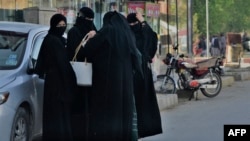At a recent three-day gathering for provincial officials of the Taliban’s Ministry for the Promotion of Virtue and Prevention of Vice, only men were in attendance. Their meeting and decisions, however, were about a new dress code for women in Afghanistan.
Inaamullah Samangani, a Taliban spokesman, told VOA that officials discussed “how to smoothly enforce the decree about the hijab."
Under the new Taliban order, all adult women are required to cover their entire body and face, with only eyes and hands an exception.
“The Islamic Emirate never and never imposes any particular kind of hijab on Afghan women but has called on women to continue wearing whatever kind of hijab that’s common in their area,” Samangani added.
Agents of the ministry — officially called religious ombudsmen — say enforcing compliance won't involve violence against women, but will instead result in penalties, including up to three days of incarceration for a male member of her family.
“An overwhelming majority of the Afghan women do observe the hijab, but only a small number of women in urban areas have been advised now to observe it,” said Samangani.
The Taliban’s decree has been met with widespread international condemnation.
“I'm alarmed by today's announcement by the Taliban that women must cover their faces in public and leave home only in cases of necessity,” United Nations Secretary-General Antonio Guterres tweeted on May 7.
On Tuesday, a small group of women in Kabul also protested the decree, saying men alone should not dictate what women wear.
Islamic or traditional?
Members of the Taliban, however, say enforcing the hijab is their Islamic obligation.
Some Islamic law scholars repudiate this, saying the Taliban’s treatment of women, including gender-specific dress codes, is inspired by rural Afghan traditions. Most Taliban leaders are reportedly educated at religious seminaries in rural Afghanistan and Pakistan.
“The Quran did not mention the word hijab as a covering for women in the same way it is used today,” Imam Feisal Abdul Rauf, an Islamic scholar and founder of the Cordoba House in New York, told VOA.
How Taliban treat Afghan women “is their culture."
"It is their opinion of the [Islamic] law, but it is not the universal opinion of the law,” Rauf added.
There is no universal type of hijab and women wear different kinds of clothes in Muslim countries around the world, which represent their cultural affiliation rather than a symbol of their faith, said Rauf.
Like the Taliban’s ban on education and outside work for women, the hijab decree has also been challenged by some Islamic scholars inside Afghanistan.
“If the Islamic Emirate has to issue a decree [about hijab], it should do so for men to prevent them from gazing sexually at women and whoever does so will be held in denial,” Misbahullah Abdul Baqi, an Islamic scholar and chancellor of a private university in Afghanistan, wrote in Pashto on a pro-Taliban website.
'Nonsensical'
For Shkula Zadran, an Afghan women’s rights activist, the Taliban’s dress code enforcement is a continuation of the group’s misogynistic policies.
Referring to the Taliban’s ban on secondary education, work and political participation, Zadran said the regime is seeking total erasure of women from the public space.
“I think [the Taliban’s] entire Jihad was evolving against women,” said Zadran, referring to the Taliban’s almost two decades of armed insurgency.
“The Taliban’s hijab decree is nonsensical,” Zadran, now a graduate student at New York University, told VOA, “because Afghanistan is already a Muslim country and women have always observed the hijab.”
Despite their return to power last August, no country has recognized the Taliban regime so far, largely due to the group’s denial of basic rights to women and a monopoly of the political power by clerics.
Some Western donors, chiefly the United States, have imposed strict financial sanctions on the Taliban, ostensibly to force the regime to respect women’s rights and form an inclusive government.
Thus far, however, the regime has proven defiant.
“Hijab is an internal, religious and faith issue in Afghanistan … the U.S. should fulfill its responsibility towards the real humanitarian issues, particularly the sanctions and seizures that have caused economic problems in the Afghan society,” said Samangani, the Taliban spokesman.
Even after the Taliban’s return to power, the U.S. has been the single largest humanitarian donor to Afghanistan and has committed more than $700 million in aid, U.S. officials said.









